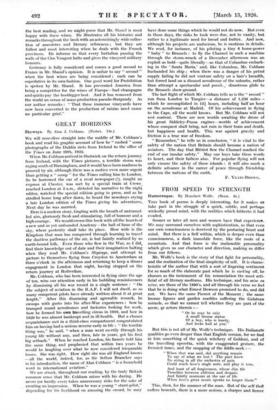GREAT HORIZONS
Skyways. By Alan J. Cobham. (Nisbet. 15s.)
WE will nose-dive straight into the middle of Mr. Cobham's book and read his graphic account of how he " rushed " some photographs of the Dublin riots from Ireland to the office of the Times on June 29th, 1922.
When Mr. Cobham arrived in Shotwick on the return journey from Ireland, with the Times pictures, a terrible storm was raging south of Birmingham, and it would have been madness to proceed by air, although there was a motive even more urgent than getting a " scoop " for the Times calling him to London. So he borrowed the car of a rival newspaper (!), caught an expresi at Chester, was met by a special train at Crewe reached London at 3 a.m., dictated his narrative to the night editor, watched the special edition going to press, and as he strolled home long after dawn, he heard the newsboys crying a late London edition of the Times giving his adventures. Next day he was married.
Here is a modern story, tingling with the breath of untramel- led airs, gloriously fresh and stimulating, full of humour and a high courage. We would crown this book with all the laurels of a new and as yet unfounded Academy—the hall of fame of the sky, where posterity shall take its place. How wide is the Kingdom that man has conquered through learning to travel the dustless pathways of the air, is but faintly realized by us earth-bound folk. Even those who flew in the War, as I did, find their knowledge out of date and their imagination halting when they read Mr. Cobham's SA-Ways, and attempt to picture to themselves flying from Croydon to Amsterdam at three o'clock in the afternoon and returning to keep a dinner engagement in London that night, having stopped on the return journey at Rotterdam.
Mr. Cobham, who has been interested in flying since the age of ten, wins our attention early in his bubbling reminiscences by dismissing all his war record in a single sentence : On the subject of aviation in the R.A.F. I will not dwell, as so many competent pilots have already written about it at great length." After this disarming and agreeable remark, he swoops with gusto into his after-War experiences : how he tramped round aerodromes and factories looking for work, how he formed his own travelling circus in 1919, and how in 1920 he was almost bankrupt and in ill-health. But a chance acquaintance met in a third-class compartment congratulated him on having had a serious reverse early in life : " the terrible thing was," he said, " when a man went merrily through his young life without any, and then, late in years, got his first big setback." When he reached London, his fiancee told him the same thing, and prophesied that within two years he would be laughing over what he now considered irreparable losses. She was right. How right she was all England knows —all the world, indeed, for, as Sir Sefton Brancker says in his introduction, the name of Alan Cobham " is a household word in international aviation."
We are struck, throughout our reading, by the truly British common sense 'that Mr. Cobham mixes with his daring. He never (or hardly ever) takes unnecessary risks for the sake of creating an impression. When he was a young " stunt-pilot," depending for his livelihood on amusing the crowd, he may have done some things which he would not do now. But even in those days, the risks he took were due, not to vanity, but rather to a legitimate need for bread and butter. And now, although his projects are audacious, he is cautious in details. We read, for instance, of his piloting a tiny 6 horse-power "baby " to Brussels : to fly the Channel in such a machine through the storm-wrack of a December afternoon was an exploit as bold—quite literally—as that of Columbus embark- ing in the ' Santa Maria,' and, like Columbus, Mr. Cobham husbanded his ship ; when there was a danger of his petrol supply failing he did not venture safety on a hair's breadth, but forced land on a disused aerodrome of the suburbs, rather than attempt a spectacular and possiLy disastrous glide to the Brussels show-ground.
The last flight of which Mr. Cobham tells us is the " record " run from London to Tangier—a distance of 1,250 miles— which he accomplished in 13/ hours, including half an hour on the aerodrome at Madrid. Of his achievement in flying to the Cape, all the world knows. But Mr. Cobham will not rest content. There are new worlds awaiting the drone of his great Siddeley-Puma engines—worlds of achievement whose conquest shall bring, not ruin in their train and death, but happiness and health. This war against gravity and friction is a true war of freedom.
" Remember," he tells us in conclusion, " it is vital to the safety of the nation that Britain should become a nation of aviators. The day that Bleriot flew the Channel marked the end of our insular safety." May our boys take these words to heart, and their fathers also. For popular flying will not only ensure the safety of these islands : it will also mark a definite advance in the career of peace through friendship between the nations of the earth.
F. YtArs-BROWN.






























































 Previous page
Previous page